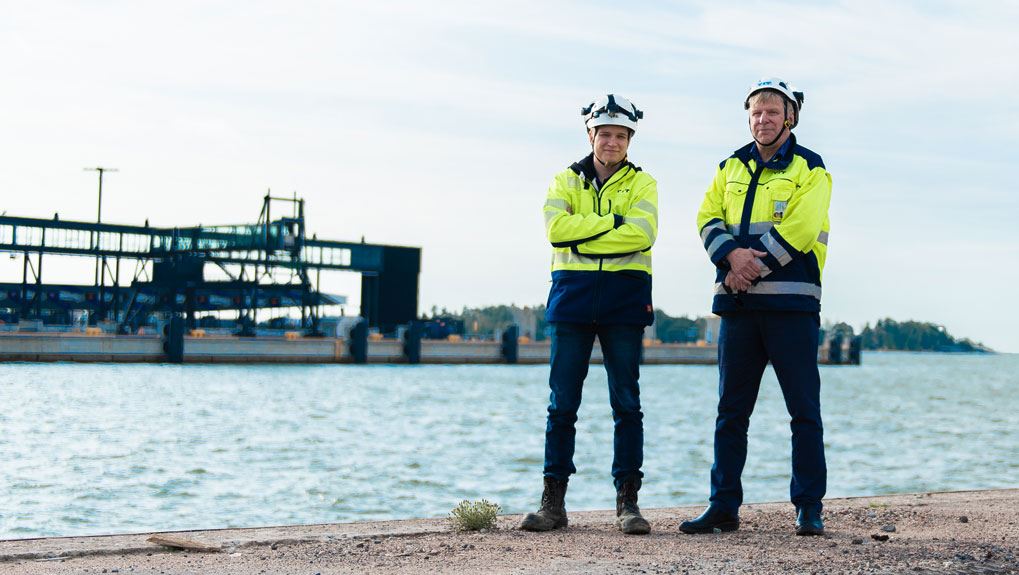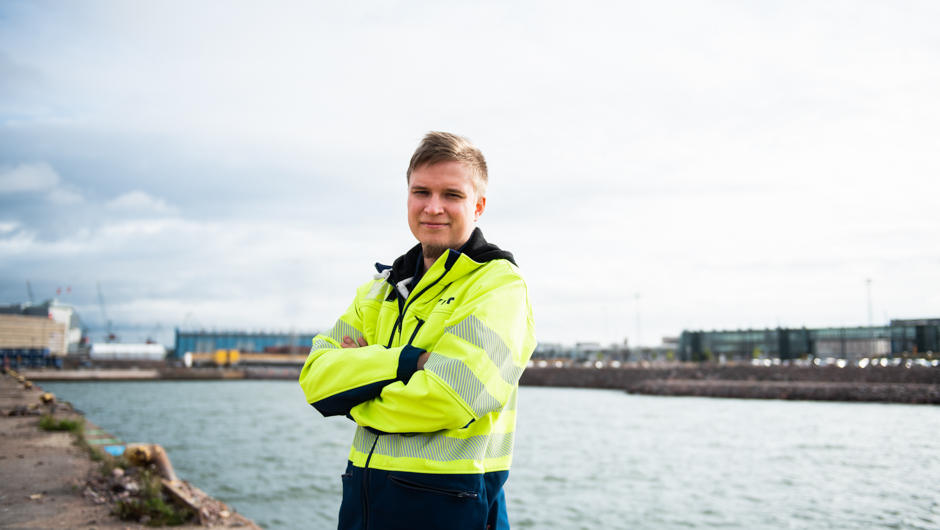- Career Story
- 9/17/2019
- 1729 views
The sea connects generations of water works and shore construction
The sea is vast and unknown but, at its best, the diversity, winds and waves can offer a lifelong learning process. This is how two of our water works and shore construction specialists, Construction Manager Urpo Merivirta (61) and Site Manager Jyrki Jussila (28), see the sea. Jyrki and Urpo were photographed by the seaside.

“I remember very well when I started working in 1984. In the spring, I graduated from the Tampere Institute of Technology as an engineer of road and water works and a week after May Day, I started my career. Back then, my employer was Vesto Oy that carried out excavations, dredging, tunnelling and bridge construction work. Quite soon, the company’s name was changed into YIT but the work has continued until today,” says Urpo, recounting the twists and turns of his career.
Jyrki represents the new generation of water works and infrastructure construction. Already as a summer worker, he saw YIT as a company that ensures that everything goes smoothly as well as looks after sites and employees. Jyrki graduated as a construction engineer from Metropolia University of Applied Sciences in 2016, and he carried out all his practical trainings at YIT. Later, this landed him a permanent job in the company.

“I was 15 when I first worked at an YIT site as an excavator assistant, and I continued with that throughout upper secondary school. Even back then, everything ran smoothly, the company made a positive impression on me and, later on, it was a natural step to apply for a job at YIT,” says Jyrki.
All the work we cannot see
Careful infrastructure construction is the foundation of large-scale projects that climb towards the sky in front of our eyes. Railroads, streets, ports, harbours and bridges can last only if they have been designed and realised in a manner meeting the requirements set by the environment. This is particularly important in water works and shore construction as outsiders can never see most of the work that has been done.
“The scales of the projects naturally vary, but the foundation has to be in order. Careful preparation ensures a good result, whether the project involves a bridge or a quay,” says Urpo.
Jyrki agrees with his older colleague and sheds light on the key principals of water works.
“In many water works and shore construction projects, the people working on the projects cannot see the construction site. This is why have to be very aware of what is happening under the surface. For instance, when steering a Merikuokka backhoe dredger, the basic work of the operator is fairly similar as in conventional earthworks but, in addition to that, you have to meet the competence requirements of water works: operators must learn how to steer a ferry, for instance. It takes the right kind of courage and will to develop. But here you are encouraged to do that.”
The Merikuokka dredger mentioned by Jyrki is one of the most common sights of water works and shore construction projects and quite stunning, in fact. The 130-tonne giant stands in the immediate vicinity of the shore.
“Practically, it is an excavator on top of a ferry used for dredging in water works and shore construction projects. Steering Merikuokka is based on a screen device that basically looks like two television screens joined together. It relays real-time information from the underwater excavation area. The rest of the steering equipment is almost the same as in so-called earthworks excavators, only larger and more demanding in that sense.”
Projects by the water can also be extremely challenging. Working in the sea can also be hazardous at times, which means that you have to trust in your experience and common sense.
“You always have to get to know your projects thoroughly and the circumstances must be monitored continuously, also during the night and at weekends. In our line of business, the sea is the greatest reason for making work difficult at times: big waves caused by the wind, fluctuation of sea level and crammed places are things we have be prepared to deal with. If these are not taken into account, something might break at the mercy of nature, which again will immediately affect the completion schedule,” says Urpo.
Unique projects leave permanent marks
The exceptional nature of water works and shore construction has left its mark on the people working in it. Over the years, YIT has realised many significant water works and shore construction projects all the way from Hamina to Tornio. Urpo speaks warmly of the most memorable projects.
“The first project that comes to mind is the Vuosaari harbour and year 2007. We built almost a kilometre of quay in Vuosaari back then. We didn’t do the edge beams but we did manufacture the elements and install them. The project was of such scale that you really don’t see that every day.”
Jyrki’s years at YIT have contained a lot, too, even though he has only just started his career. The first project at Jätkäsaari, Helsinki was a powerful experience for a young man. In addition, Juha Vainion katu in Kotka is among the finest projects he has had the privilege of participating in.
“Before the ocean pier in Jätkäsaari, I had operated a regular excavator. But then I got to go on the ferry and saw a machine ten times the size of an excavator – that alone was enough to impress me. In Kotka, Juha Vainion katu was a challenging project in which a new street, sidewalk, lighting and a bridge were built on a fill. The project was a success and turned out so good I think I’m allowed to be a little bit proud of it.”
In the middle of Jyrki’s story, Urpo cannot help but reminisce a project in Kotka.
“One of the most pleasant projects of my career has been the Jänskä pier. Even though it was a small project, it was in such a great and protected location that it was a pleasure working on it. Back then, you could design everything from the start: how the casting is done and how different elements are made, how they are installed – and when you had experts doing on the job, everything went smoothly. It was a fun project.”
Dividing the legacy of competence
A key thing about cherishing the legacy of water works and shore construction is that young professionals are included in a group of experienced and seasoned experts. Jyrki appreciates having a construction veteran like Urpo as his working partner.
“Even if it hasn’t been that long since I was in school, I’ve learnt the most from people like Urpo who have been in this line of business for decades and decades. They have some many old tricks and good ideas to share that listening to them carefully is essential.”
Urpo agrees upon the importance of discussing ideas and views with the younger generation.
“Even on a daily level, everyone must have a working partner or someone to exchange ideas with. Sometimes ideas fly high but there should always be a right ratio of experience, knowledge and will to learn new things. It has always been like that with us.”
The pictures of Urpo and Jyrki have not been taken at a work site.
Urpo Merivirta
Age: 61
How long have you been working at YIT? First, 3 years at Vesto Oy, and after the merger, 32 years at YIT
And in the construction industry? 35 years
Why did you apply to YIT? The wide selection of work corresponding to my education
The greatest project of your career? The ocean pier at Jätkäsaari
Jyrki Jussila
Age: 28
How long have you been working at YIT? 5 years
And in the construction industry? 5 years
Why did you apply to YIT? Summer work experiences that left a good impression on me
The greatest project of your career? Juha Vainion katu in Kotka



